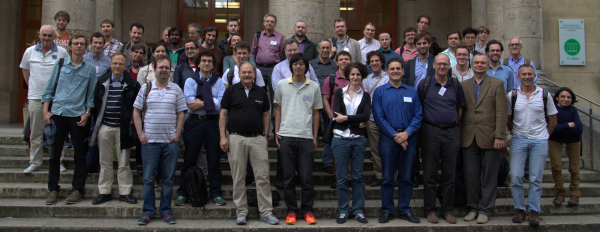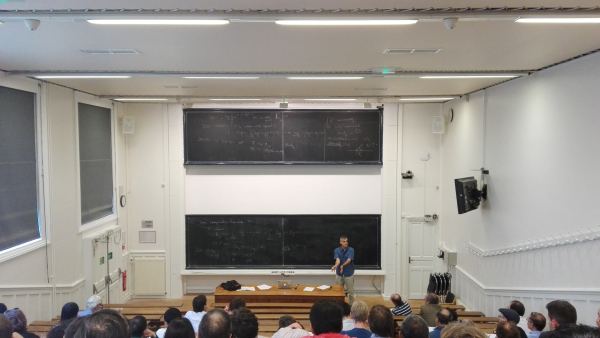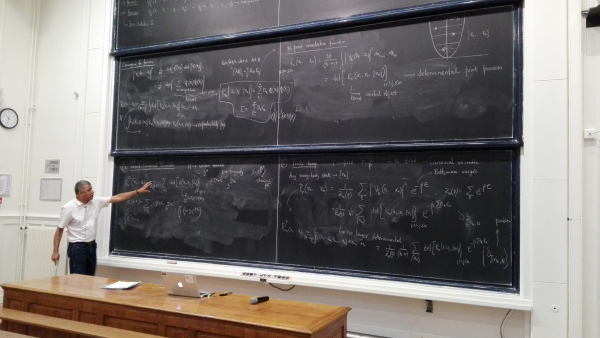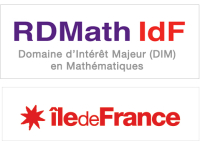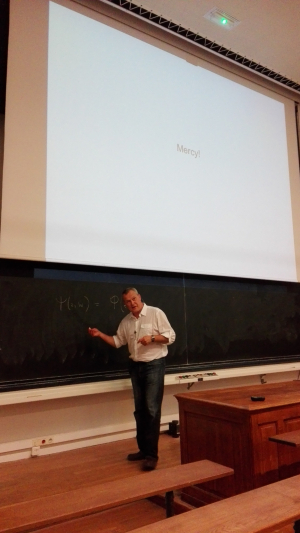Optimal and random point configurations
From Statistical Physics to Approximation Theory
Institut Henri Poincaré, Paris – June 27 – July 1, 2016 – Amphi Hermite
This one week conference aims at bringing together the communities of probabilists, statistical physicists, approximation theorists, and analysts, who work with different points of view on issues of optimal and random point configurations such as Fekete sets, Coulomb gases, point processes arising in random matrices, and crystallization questions.
While the schedule of talks is full, submissions of presentation at the poster session, in particular of young researchers, are encouraged.
Conference Poster (13MB, created by Th. Leblé and S. Serfaty)
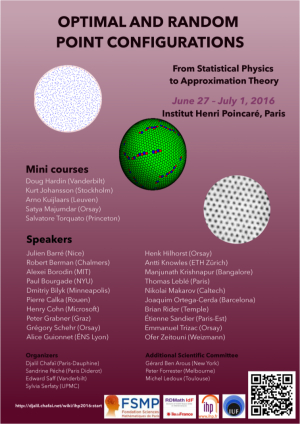
Schedule
| Schedule | Mon 27 | Tue 28 | Wed 29 | Thu 30 | Fri 1 |
|---|---|---|---|---|---|
| 09:30-11:00 | Torquato | Johansson | Kuijlaars | Hardin | Majumdar |
| 11:00-11:30 | Break | Break | Break | Break | Break |
| 11:30-12:30 | Torquato | Johansson | Kuijlaars | Hardin | Majumdar |
| 12:30-14:00 | Lunch | Lunch | Lunch | Lunch | Lunch |
| 14:00-14:45 | Rider | Berman | Zeitouni | Leblé | Bilyk |
| 14:45-15:30 | Barré | Guionnet | Trizac | Ortega-Cerda | Hilhorst |
| 15:30-16:00 | Break | Break | Posters | Break | Break |
| 16:00-16:45 | Schehr | Bourgade | Grabner | Calka | |
| 16:45-17:30 | Sandier | Knowles | Hardy | Makarov |
Speakers
- Mini-courses. (2h30 each, one per day)
- Doug Hardin (Vanderbilt). Minimal discrete energy on rectifiable sets. The problem of finding point configurations that minimize a repulsive energy functional appears in a number of guises including best-packing problems, coding theory, ground state problems, node distribution, and statistical physics. I will review both classical and recent methods and results for estimating the energy and geometrical properties of energy-minimizing configurations. Topics will be chosen from an upcoming book in preparation with S. Borodachov and E. Saff.
- Kurt Johansson (Stockholm). Determinantal processes. Determinantal processes form an interesting class of point processes with many interesting properties and patterns. I will give an introduction to the basic facts about these processes and then give several examples from random matrix theory, random tilings and dimer models, and random growth. In connection with these examples I will discuss central limit theorems and scaling limits. Some of the examples are classical but I will also talk about some more recent results.
- Arno Kuijlaars (Leuven). Determinantal point processes and products of random matrices. Determinantal point processes are random point configurations with a built-in repulsion between nearby points. Because of the determinantal structure, many tools from linear algebra and combinatorics become available to find explicit formulas for n-point determinantal point processes, which can then be used to establish limiting result as n tends to infinity. I will present the basic properties of determinantal point processes and illustrate them for the special case of eigenvalues and singular values of products of random matrices. The limits that one can compute here involve the sine kernel and Airy kernel but also more involved kernels with so called Meijer G-functions.
- Satya Majumdar (Orsay). Cold atoms, free fermions and the Kardar-Parisi-Zhang equation. There have been spectacular progress in cold atoms experiments in recent years. As a simple example of a system of noninteracting cold atoms, I'll discuss the case of N free fermions trapped in a harmonic well. We will see that even without interactions, this is an interesting many-body system with nontrivial quantum fluctuations arising purely from the Pauli exclusion principle. In 1d and at T=0, the quantum fluctuations of the positions of the fermions can be exactly mapped to the distribution of eigenvalues of a Gaussian Hermitian random matrix. A lot of nice exact results for the fermions can be extracted using this correspondence. In particular, this connection to random matrix theory predicts exact results at the edges of the fermion density profile, where fluctuations dominate and traditional theories of quantum many-body systems do not work. One example of such exact results at the edges is that the position of the rightmost fermion in 1-d, at T=0, is described by the celebrated Tracy-Widom distribution for the top eigenvalue of a random matrix. I'll then discuss how these results can be generalized to finite temperature. Remarkably, at finite T, the position of the rightmost fermion is closely related to distribution as the height at finite time of the (1+1)-dimensional interfaces described by the continuum Kardar-Parisi-Zhang equation. Interesting results at finite temperature can be derived by exploiting this connection as well. If time permits, I'll also discuss the generalisations to higher dimensions.
- Salvatore Torquato (Princeton). Optimal and Disordered Hyperuniform Point Configurations. Hyperuniform point configurations in d-dimensional Euclidean space are characterized by a suppression of density fluctuations in a hypersphere of radius R relative to those in a Poisson point configuration that tends to zero in the large-R limit. All perfect periodic point configurations are hyperuniform but the degree to which they suppress large-scale density fluctuations varies and the optimal arrangement in any dimension can be stated as an energy minimization problem that is closely related to the minimization of the Epstein zeta function. Remarkably, there are special disordered hyperuniform point configurations that arise in a host of contexts across physics, mathematics and biology. Examples include maximally random jammed packings, Coulomb gases, certain fermionic and bosonic systems, the Peebles-Harrison-Zeldovich spectrum of primordial density fluctuations, liquids that freeze into degenerate disordered ground states, spatial patterning of photoreceptors in avian retina, structure of neuronal tracts, highly excited states of ultracold gases of atoms, driven nonequilibrium systems and determinantal point processes. I will give an overview of fundamental aspects of optimal and disordered hyperuniform point configurations across dimensions.
- Talks. (45' each, four per day)
- Julien Barré (Nice). On Magneto-optical traps seen as Coulomb gases with non conservative interactions. Magneto-optical traps are routinely used in cold atoms physics. In these devices, clouds of atoms are kept confined at low temperature by a set of lasers, tuned close to an atomic resonance. Multiple scattering of photons induces an effective long-range repulsion in the system, so that in certain parameter ranges, the cloud bears similarities with a Coulomb gas. However, a better modeling requires the introduction of a non conservative attractive interaction. I will explain the modeling process at an introductory level, point out the difficulties raised by the non conservative force, and present of its qualitative effects.
- Robert Berman (Chalmers). From the statistical mechanics of interpolation nodes to complex geometry and optimal transport. There is well-known notion of optimal nodes for interpolating polynomials of large degree in complex space, generalizing the classical notion of Fekete points in the complex plane. In this talk I will explain how a dynamical statistical mechanical approach for locating nearly optimal interpolation nodes leads to some rather surprising connections to complex geometry (Kähler-Einstein metrics on complex algebraic varieties). Moreover, through a process of tropicalization, one then arrives at a sticky particle type system formulated in terms of optimal transport.
Alexei Borodin (MIT). (Canceled – April 10, 2016)- Paul Bourgade (NYU). Rigidity of one-component plasma in 2D. The one-component plasma (OCP) is a Coulomb gas of N equal negatively charged particles (in the continuum) confined by a potential. In two dimensions, for a special temperature, it is integrable as a determinantal point process, and the system can be understood is much detail. I will discuss a proof that fluctuations are much smaller than for a Poisson process, at all finite temperatures. This is joint work with Bauerschmidt, Nikula, and Yau.
- Dmitriy Bilyk (Minneapolis). Stolarsky-type identities, energy optimization, uniform tessellations, and one-bit sensing. We shall discuss various relations between different problems of optimal distributions of points on a sphere. The classical Stolarsky principle states that minimizing the spherical cap $L^2$ discrepancy is equivalent to maximizing the sum of (Euclidean) distances between the points. We shall state a variety of similar principles arising in different geometric settings. In particular, for hemisphere discrepancy a very similar principle holds with the geodesic distance in place of Euclidean. This in turn leads leads to a surprising difference in the behavior of the corresponding energy integral based on geodesic distance, compared to the standard Riesz energy integral. We shall also discuss the problem of uniform tessellation of the sphere by hyperplanes, which gives rise to a new notion of discrepancy, and its connections to the so-called one-bit compressed sensing. We prove a number of results that essentially state that one-bit sensing is theoretically as good as the standard compressed sensing. We also obtain a Stolarsky-type principle in this setting.
- Pierre Calka (Rouen). Asymptotic study of random polytopes. We consider a set of random points in the Euclidean space which are independent and identically distributed and we construct its convex hull. We aim at describing the asymptotic behavior of this random polytope when the size of the input goes to infinity. In particular, we investigate several functionals such as the number of k-dimensional faces and the volume when the points are uniformly distributed in a fixed convex body, either smooth and polytopal, or when they follow a standard Gaussian distribution. The first results on that topic date back to the seminal works in the planar case due to Rényi and Sulanke in 1963 and 1964. Since then, asymptotic mean values with explicit constants have been derived in any dimension in the literature as well as bounds for the variances and central limit theorems. We present a new method which provides the explicit calculation of limiting variances in the cases of uniform points in a smooth convex body, Gaussian points and uniform points in a simple polytope. We then focus on the particular cases of uniform points in the unit-ball and especially of uniform points in a simple polytope. We explain in particular how the variance asymptotics can be deduced from a scaling limit of the boundary of the random polytope and of its associated so-called flower. The technique relies in particular on results obtained by Bárány and Reitzner in 2010 on the approximation of the random polytope by floating bodies associated with the mother body. This talk is based on a joint work with Tomasz Schreiber and Joe Yukich and on several joint works with Joe Yukich.
Henry Cohn (Microsoft research). (Canceled – June 15, 2016)- Peter Grabner (Graz). Hyperuniformity on the sphere. The concept of hyperuniformity had been introduced by S. Torquato and F. Stillinger to measure regularity of distributions of infinite particle systems in $\mathbb{R}^d$. An infinite particle system $X\subset\mathbb{R}^d$ is called hyperuniform, if the variance (with respect to the thermodynamic limit) of the number of points in a large ball is smaller than “usual”: $\mathbb{V}\#(X\cap B(\mathbf{x},R))=\mathcal{O}(R^{d-1})$ for $R\to\infty$. Notice that this variance is of order $R^d$ for Poisson point processes. We generalise this concept to the sphere and the torus by considering sequences of finite point sets $(X_N)_N$ (with $\# X_N=N$). The phenomenon of a “smaller than usual” variance of the point counting function is then be observed for geodesic balls with $N\mathrm{vol}(B_R)\to\infty$ but $\mathrm{vol}(B_R)\to0$. We will discuss several examples of hyperuniform sequences of point sets. Joint work with J. Brauchart, W. Kusner, and J. Ziefle.
- Alice Guionnet (ÉNS Lyon). Discrete Beta-models. We will discuss discrete analogues of beta models that arise in tiling problems and show how to analyze the fluctuations of their linear statistics by Nekrasov's equations. Based on joint works with A. Borodin, G. Borot, and V. Gorin.
- Adrien Hardy (Lille). Determinantal processes in higher dimension and application to Monte Carlo. Can we speed up Monte Carlo methods by using repulsive random point configurations? To answer this question, we consider a class of determinantal point processes built with multivariate orthogonal polynomials and obtain a central limit theorem for smooth test functions. One interesting feature is that the variance of linear statistics behaves like $N^{1-1/d}$, where $N$ is the number of points in the configuration, which is to compare to the $N$ behavior in the independent case. Thanks to this, we can construct a Monte Carlo method with an error rate decaying faster than for usual Monte Carlo methods. This is a natural stochastic counterpart to Gaussian quadrature, which has the advantage to make sense in any dimension. Joint work with Rémi Bardenet.
- Henk Hilhorst (Orsay). Extreme events in Poisson-Voronoi tessellations. Given a set of point-like “seeds” in $d$-dimensional Euclidean space, the associated Voronoi tessellation is the partitioning of space into cells such that each point of space is in the cell of the seed to which it is closest. In the case of independent and uniformly distributed seeds one speaks of a Poisson-Voronoi tessellation. We will discuss the statistical properties of rare or “extreme” cells: those (in $d=2$) that have a large number $n$ of sides; or (in $d=3$) that have a large number $n_F$ of faces, or that have a face with a large number $n_E$ of edges. Calculating the probability of such events reveals the entropic forces that are at play. Whereas microscopically we are facing a stochastic many-body problem, we will show that macroscopically there arise deterministic laws when $n$, $n_F$, or $n_E\to\infty$.
- Antti Knowles (ETH Zürich). Gibbs measures of nonlinear Schrödinger equations and interacting quantum particles at high temperature. Many time-dependent nonlinear Schrödinger equations admit an invariant Gibbs measure, which is a probability measure on the space of distributions that is left invariant by the time evolution. Such measures have been extensively studied as tools to construct global solutions of time-dependent nonlinear Schrödinger equations with rough initial data. I review recent progress on deriving these measures as high-temperature limits of many-body quantum mechanics. In dimensions larger than one, the Gibbs measures are supported on distributions of negative regularity, and a renormalization procedure by Wick ordering is necessary. On the quantum many-body side, the need for renormalization is manifested by a rapid growth of the number of particles.
Manjunath Krishnapur (Bangalore). (Canceled due to a visa problem – June 7, 2016)Gap probabilities for stationary Gaussian processes and for point processes in the plane.For a stochastic process indexed by integers, what is the probability that it stays above zero for a long time? For a point process on the plane, what is the probability that it puts no points in a large disk of radius r? By gap probabilities (also called persistence probabilities or hole probabilities), we mean such quantities. In this lecture we shall review known results, old and new, for two situations: (a) For a stationary, centered Gaussian process on integers and (b) For the infinite Ginibre ensemble, a translation invariant point process in the plane. In both cases, the relationship to a large deviation question will be discussed. New results on the point processes will be based on works of Kartick Adhikari and Nanda Kishore Reddy and the work on stationary Gaussian processes is based on joint works with Krishna Maddaly and with Rajesh Sundaresan.- Thomas Leblé (Paris). Logarithmic, Coulomb and Riesz Gases: microscopic behaviour and fluctuations. We consider N particles interacting via a long-ranged potential, e.g. Coulomb or Riesz, or a logarithmic interaction - in which case the Gibbs measure coincides with the law of eigenvalues of important random matrix models. The global behaviour for large N is well-known from classical potential theory. We characterize the microscopic behaviour through a Large Deviation Principle for the law of the empirical fields. For the 1d log-gas, we apply our results to the limiting sine-beta point processes emerging in random matrix theory. For the 2d log-gas, we bound the fluctuations of the empirical measure at any mesoscopic scale and we give a CLT which was only known in the determinantal case. Based on joint works with S. Serfaty.
- Nikolai Makarov (Caltech). Random normal matrices with hard edge spectrum. We will discuss the problems of existence and universality of the scaling limit for the eigenvalues of a random normal matrix, in particular near the hard edge of the spectrum. Our approach uses rescaled Ward's equation and analyticity properties of the correlation kernels. This is a joint work with Yacin Ameur and Nam-Gyu Kang.
- Joaquim Ortega-Cerda (Barcelona). Energy and discrepancy of rotationally invariant determinantal point processes in high dimensional spheres. We study expected Riesz s-energies and linear statistics of some determinantal processes on the sphere. In particular, we compute the expected Riesz and logarithmic energies of the determinantal processes given by the reproducing kernel of the space of spherical harmonics. This kernel defines the so called harmonic ensemble on the sphere. With these computations we improve previous estimates for the discrete minimal energy of configurations of points in the sphere. We prove a comparison result for Riesz 2-energies of points defined through determinantal point processes associated to isotropic kernels. As a corollary we get that the Riesz 2-energy of the harmonic ensemble is optimal among ensembles defined by isotropic kernels with the same trace. Finally, we study the variance of smooth and rough linear statistics for the harmonic ensemble and compare the results with the variance for the spherical ensemble and the determinantal processes given by Bochner-Riesz kernels.
- Brian Rider (Temple). A Universality result for the random matrix hard edge. The hard edge refers to the distribution of the smallest singular value for certain ensembles of random matrices, or, and what is the same, that of the minimal point of a logarithmic gas constrained to the positive half line. For any “inverse temperature” and “quadratic“ potential the possible limit laws (as the dimension, or number of particles, tends to infinity) was characterized by Jose Ramirez and myself in terms of the spectrum of a (random) diffusion generator. Here we show this picture persists for more general convex polynomial potentials. Joint work with Patrick Waters.
- Étienne Sandier (Paris-Est). Asymptotic Expansion of Optimal Logarithmic Energy on the Sphere. We study the Hamiltonian of a two-dimensional log-gas with a confining potential $V$ growing like log near infinity, a case previously considered by Hardy and Kuijlaars. We identify an additional term in the asymptotic expansion as the number n of points goes to infinity using techniques of Sandier-Serfaty and Rougerie-Serfaty. This allows to reformulate thus corroborate a conjecture of Brauchart-Hardin-Saff. This is a joint work with Laurent Betermin.
- Grégory Schehr (Orsay). Statistics of the real roots of real random polynomials. I will present a study of various statistical properties of real roots of three different classes of random polynomials, of degree n: (generalized) Kac polynomials, Weyl and Binomial polynomials. I will show in particular that the gap probability on the real axis, i.e. the probability that these polynomials have no real root in a given interval, is related, when the degree n is large, to the persistence (or first passage) properties of the heat equation with random initial conditions. I will also present results for the probability that such polynomials have exactly k roots in a given interval. Finally, I will discuss a family of real random polynomials exhibiting a phenomenon of condensation of the roots on the real axis.
- Emmanuel Trizac (Orsay). Polymorphism in Wigner bilayer crystals. What is the optimal configuration of Coulomb charges in a bilayer geometry ? This question generalizes that raised by Wigner in the 1930s (where a monolayer geometry was addressed), and appears as a variant of Thomson's classic raisin pudding model. Combining analytical calculations and computational techniques of evolutionary and Monte Carlo types, we obtain the ground state phase diagram of the problem, that exhibits a wealth of Wigner crystals, with unexpected features (long-range attraction, appearance of macroscopic charges, exotic phases, and non conventional phase transitions with distinct critical indices). This results in the possibility of a fine and convenient control of self-assembled patterns. Work in collaboration with M. Antlanger, M. Mazars, G. Kahl and L. Samaj.
- Ofer Zeitouni (Weizmann). Large deviations for the empirical measure of zeros of random polynomials: Gaussian and beyond. We consider Kac polynomials of the form $\sum_{i=0}^n a_i z^i=a_n\prod (z-z_i)$ and the associated empirical measure $L_n=n^{-1}\sum \delta_{z_i}$, where $a_i$ are iid. The LDP for $L_n$ (at scale $N^2$) in the Gaussian case was proved a few years ago by Zelditch and the speaker. I will describe recent results concerning the exponential case and the case of general iid coefficients with mild restrictions on their distribution. Based on joint works with Subhro Ghosh and Raphael Butez.
- Posters. (Wednesday Room 5 15:30–17:30)
- Sergiy Borodachov (U. Towson, USA)
- Juan G. Criado del Rey (U. Cantabria, Spain)
- Ujué Etayo (U. Cantabria, Spain)
- Sergey Frenkel (Russian Academy of Sciences, Russia)
- Oleksandr Vlasiuk (Vanderbilt U., USA)
Registration
Registration is free but mandatory, and, for organizational reasons, it is important that you register using the form below.
| # | Participants | Affiliation |
|---|---|---|
| Chafaï, Djalil | Univ. Paris-Dauphine, Paris, France | |
| Peche, Sandrine | Univ. Paris Diderot, Paris, France | |
| Serfaty, Sylvia | UPMC - Paris 6, Paris, France | |
| Ortega Cerdà, Joaquim | Univ. de Barcelona, Spain | |
| Marzo, Jordi | Universitat de Barcelona, Spain | |
| Bilyk, Dmitriy | University of Minnesota, USA | |
| Petrache, Mircea | MPI Leipzig, Germany | |
| Musin, Oleg | University of Texas Rio Grande Valley, USA | |
| Khavinson, Dmitry | University of South Florida, USA | |
| Borodachov, Sergiy | Towson University, USA | |
| Kerkyacharian, Gerard | LPMA, Paris, France | |
| Trizac, Emmanuel | Univ. Paris-Sud, Orsay, France | |
| Kallus, Yoav | Santa Fe Institute, USA | |
| Calka, Pierre | Univ. de Rouen, Rouen, France | |
| Stoyanova, Maya | FMI, Sofia University, Sofia, Bulgaria | |
| Akakpo, Nathalie | LPMA, Paris, France | |
| Wang, Yuguang | UNSW, Sydney, Australia | |
| Hardy, Adrien | Université de Lille 1, France | |
| Lambert, Gaultier | KTH, Stockholm, Sweden | |
| Dragnev, Peter | Indiana University-Purdue University Fort Wayne, USA | |
| Benaych-Georges, Florent | Université Paris Descartes, France | |
| Stivigny, Dries | KU Leuven, Belgium | |
| Brauchart, Johann | Graz University of Technology, Austria | |
| Attia, Mohamed Jalel | Faculty of sciences Gabès, Tunisia | |
| Mojtaba, Bakherad | University of Sistan and Baluchestan, Zahedan, Iran | |
| Dzhalladova , Irada | Kyiv National Economical University, Ukrain | |
| Merzbach, Ely | Bar-Ilan University, Israel | |
| Osting, Braxton | University of Utah, USA | |
| Reznikov, Aleksandr | Vanderbilt University, USA | |
| Vlasiuk, Oleksandr | Vanderbilt University, USA | |
| Ziefle, Jonas | Technische Universität Graz, Austria | |
| Kusner, Wöden | Graz University of Technology, Austria | |
| Dimitrakopoulou, Katerina | National and Kapodistrian University of Athens | |
| Hajej, Ahmed | Univ. Paris-Dauphine, Paris, France | |
| Comets, Francis | Paris Diderot | |
| Sabonis, Deividas | TU Munich | |
| Soshnikov, Alexander | UC Davis | |
| Galkin, Valerii | Surgut State University, Russian Federation | |
| Galkina, Irina | Polytechnic Inst. Surgut State University, Russian Federation | |
| Shahin, Sabina | Hanyang University South Korea | |
| Bétermin, Laurent | Mathematics Center Heidelberg | |
| CAFASSO, Mattia | Université d'Angers | |
| Rouault, Alain | Université Versailles-Saint-Quentin | |
| ZHENG, GUANGQU | Université du Luxembourg | |
| Donati-Martin, Catherine | Université de Versailles St Quentin | |
| Salnikova, Tatiana | Lomonosov Moscow State University | |
| Bekerman, Florent | MIT | |
| Djeffal, El Amir | Universty Hadj Lakhdar, Batna, Algeria | |
| Cunden, Fabio Deelan | University of Bristol (UK) | |
| Rouault, Alain | Université Versailles-St-Quentin | |
| Kalimulina, Elmira Yu. | Institute of Control Sciences of Russian Academy of Sciences | |
| Maida, Mylene | Université Lille 1 | |
| Pautrat, Yan | Université Paris-Sud | |
| Kikawa, Cliff Richard | Tshwane University of Technology, Republic of South Africa | |
| Cawood, Mark | Clemson University | |
| Saff, Edward | Vanderbilt University | |
| Hamaizia, Tayeb | Department of Mathematics, Faculty of Sciences Exacts, University Constantine -1- Algeria | |
| El Kinani , El Hassan | ENSAM. Université Moulay Ismaïl, Meknès | |
| El-Nadi, Khairia | Professor of statistics | |
| El-Borai, Mahmoud | Faculty of Science Alexandria University Egypt | |
| Lounici, Karim | Georgia Inst. of Technology | |
| Saeid, Rezakhah | Amirkabir University of Technology, Tehran, Iran | |
| zermani , samia | faculté des sciences de tunis | |
| Herry, Ronan | Luxembourg - UPEM | |
| Onicha, Jude | University of Benin | |
| Migliorati, Giovanni | Université Pierre et Marie Curie | |
| Bazaikin, Yaroslav | Sobolev Institute of Mathematics | |
| Etayo, Ujué | Universidad de Cantabria | |
| Qin, Yingdi | uc berkeley | |
| G. Criado del Rey, Juan | Universidad de Cantabria | |
| Allaoui, Salah Eddine | Département de mathématiques,Université de Laghouat,Algérie | |
| Barré, Julien | Université de Nice | |
| Feng, Renjie | Peking University | |
| Salimian, Mahboobeh | Industrial University of Shahroud | |
| Malkovich, Evgeny | Sobolev Institute of Mathematics | |
| Pritsker, Igor | Oklahoma State University | |
| Dorville, René | Université des Antilles | |
| Seco, Daniel | Universitat de Barcelona | |
| Bardenet, Rémi | CNRS & Univ. Lille | |
| EGE, NIHAL | Anadolu University | |
| Michaels, Tim | Vanderbilt University | |
| Bondarenko, Valeria | University of Montpellier, Department of Economics,LAMETA | |
| Wu, Wei | New York University | |
| Chen, Hanfeng | Bowling Green State University | |
| Levenberg, Norman | Indiana University | |
| de Gournay, frederic | IMT, Toulouse | |
| Sergey, Frenkel | Institute of Informatics problems of Russian Academy of Sciences | |
| Kozak, Liudmyla | Kyiv Taras Shevchenko University, Ukraine | |
| Simm, Nicholas | University of Warwick | |
| Matos, Ana | Université de Lille 1 | |
| Kim, Seung-Yeon | Korea National University of Transportation | |
| Desolneux, Agnès | ENS Cachan | |
| Di Marino, Simone | Université Paris-Sud | |
| Lee, Julian | Soongsil university | |
| Galerne, Bruno | Université Paris Descartes | |
| Kozak, Pavlo | Astronomical Observatory of Kyiv Taras Shevchenko National University | |
| Le Foll, Yves | ENSTélécom (retraité) | |
| Wen, Yuting | University of Melbourne | |
| nguyen, Vu LAn | Paris 7 | |
| García Zelada, David Enrique | Univ. Paris-Dauphine | |
| Dornic , Ivan | Cea Saclay | |
| Zeng, Robin | Dartmouth College | |
| Khimshiashvili, Giorgi | Ilia State University, Tbilisi, Georgia | |
| Olugbenga, Ifedola | Michael Otedola College of Education | |
| torquato, salvatore | Princeton University | |
| Fahs, Benjamin | Université Catholique de Louvain | |
| Butez, Raphael | Université Paris Dauphine | |
| Yushu, Li | University of Bergen | |
| Hegde, Omkar | National Institute of Technology Karnataka, India | |
| Leblé, Thomas | Université Pierre et Marie Curie | |
| xia, bo | LM-Orsay | |
| Mourah, Nawel | Université 20 Août 1955 Skikda ALgérie | |
| Ménard, Laurent | Modal'X | |
| le doussal, pierre | LPTENS Ecole Normale Superieure (Paris) | |
| Grabner, Peter | Graz University of Technology | |
| Noiry, Nathan | Modal'X | |
| Ledoux, Michel | University of Toulouse, France | |
| Dereudre, David | Université Lille 1 | |
| MENDY, Albert | SAINT THOMAS INSTITUTE OF PROFESSIONAL STUDIES | |
| Dallaporta, Sandrine | ENS Cachan | |
| Kahn, Jonas | CNRS (Toulouse) | |
| Brosse, Nicolas | Ecole Polytechnique | |
| CONT, Rama | CNRS & Imperial College London | |
| Hardin, Doug | Vanderbilt University | |
| Sazonova, Olena | V.N. Karazin Kharkiv National University |
Registration is over!
Publication
A special issue of Constructive Approximation entitled “Approximation and Statistical Physics” will be guest edited by Peter Forrester, Doug Hardin, and Sylvia Serfaty. For any questions related to this forthcoming issue, please contact one of these special editors or Ed Saff. Flyer (PDF)
Accommodation
Since June in Paris is a very heavy travel season, in particular with the Euro football championship happening in June 2016, we strong advise to book an accommodation as early as possible.
Organizers & Committee
- Organizers
- Djalil Chafaï (Université Paris-Dauphine)
- Sandrine Péché (Université Paris Diderot)
- Edward Saff (Vanderbilt University)
- Sylvia Serfaty (Université Pierre et Marie Curie)
- Additional scientific committee
- Gérard Ben Arous (New York University)
- Peter Forrester (University of Melbourne)
- Michel Ledoux (Université de Toulouse)



